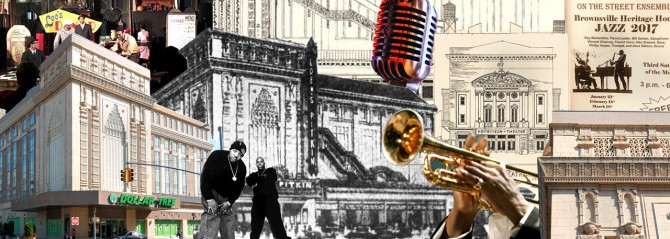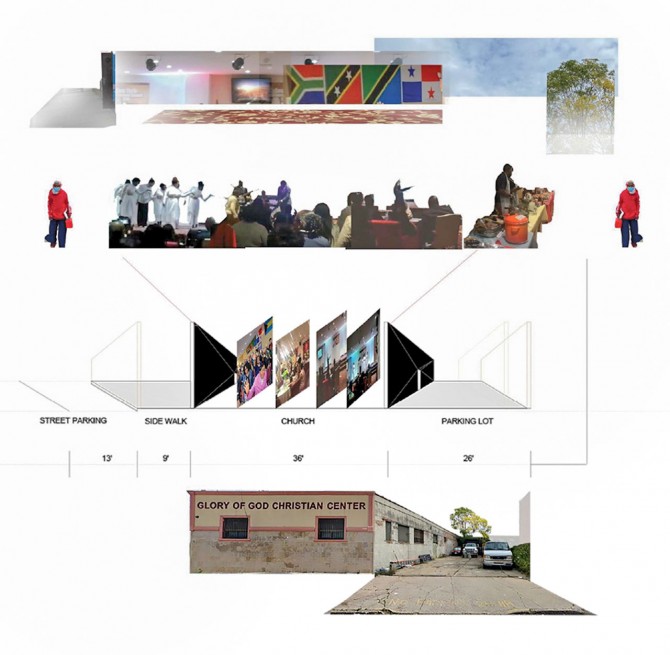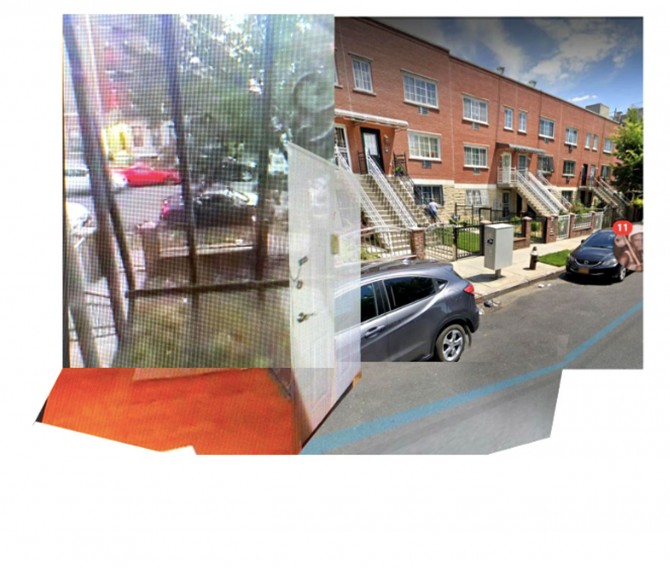Architect Peter Robinson, B.Arch. '98, visiting critic at the College of Architecture, Art and Planning (AAP), focuses on urban design as a way to engage in social action. He helped found the BlackSpace Urbanist Collective, a group of Black urban planners, architects, artists, activists, designers and leaders working to protect and create Black spaces.
Here we ask him about the importance of design practices that are shaped by site and community partnerships, and his fall 2020 AAP NYC Studio - a collaboration between architecture and planning students and young Black men who attend Medgar Evers College Preparatory School in Brooklyn.
How did you decide on architecture for your studies and career?
My interest in architecture and being an architect started at the public high school I attended. I had what I would call uncommon access to important resources that aren't often available to high school students, in particular Black students.
Visiting Critic Peter Robinson, center, works with two AAP students during his fall 2020 studio, "Housing + Sociality, My Brother's Keeper," in the Gensler Family AAP NYC Center.
Anne Buerger '65, an AAP alum who studied fine art, taught my [high school] architecture studio. She treated us all with respect and introduced me to the practice and studio culture of architecture, which prepared me for Cornell. A mentorship program as well as an internship I did as a high school student made me more comfortable applying to Cornell, and, as a young Black man entering a profession where we represent only about 2% of practicing architects, these experiences were invaluable.
There is a picture I keep with me and show other people of my friend and me in high school when we first studied architecture; we are both architects today in a profession where there hasn't really been a place for us. I show this picture often and always tell the students to come out and say what it is that they want and things can start to come together, to really happen.
How is your involvement with the BlackSpace Urbanist Collective central to your work as an architect and educator?
I was at Cornell at a time when a growing number of Black and other minority students had created a network of support, the Minority Organization of Architecture, Art and Planning (MOAAP). Relationships were built there and we maintain that network of support professionally and personally today. Three members of the BlackSpace inaugural board are AAP alums: myself, Ifeoma Ebo, B.Arch. '02, and Emma Osore, B.Arch. '09. We didn't meet at Cornell, and all had different experiences there, but there was a network in New York City so we knew of each other.
At BlackSpace, we are a collective of planners, architects and artists who share common interests and a focus on Black communities, Black experiences and Black futures - and we all came together pretty organically after two women met at the first Black In Design conference in 2015 and decided to continue the conversations that were inspired by the conference.
Today, we are guided by our BlackSpace Manifesto. It's a collection of 14 guiding principles on how to work in and with Black communities. These aren't slogans but really meant as starting points for valuable engagement. The manifesto developed organically during our meetings and discussions. In 2017, a core team was assembled to formalize and concretize what was, at the time, an evolving ethos.
This collage was made by students in architect Peter Robinson's fall 2020 studio, "Housing + Sociality, My Brother's Keeper." The students conducted collaborative design research to better understand the historical and current issues in Black spaces in Brownsville and other Brooklyn neighborhoods.
The high schoolers in your fall 2020 AAP NYC studio participate in the My Brother's Keeper (MBK) program, an alliance founded by President Barack Obama to "build safe and supportive communities for boys and young men of color." How did they and the AAP students respond to the studio's guiding question, "How can we radicalize spatial thinking in such a way that the bodies and consciousness of young Black men are the solution and not the problem in housing?"
The studio wasn't as much a formal housing studio as it was a studio about living. It was important that the central focus for work in a Black community, and work in collaboration with young Black men, was specifically not a problem. We were not dealing with a problem to solve with design. In part because young Black men were present in the studio, we were reminded that we're dealing with people rather than a design problem to be solved.
The humanity in that allowed for specificity, difference and different ways of articulating knowledge and experience, which meant everyone had something to learn from each other. As an instructor, I needed to step back and let our ideas change about design and what architecture could be, as determined by what these 14 young Black men shared in conversation with the Cornell students they were collaborating with.
Sometimes we ended up with confusion over how to proceed when initial questions were answered in unexpected ways, and conversations took a different turn. Simple questions such as, "What does home mean to you?" resulted in working with a Nigerian Evangelical church that was more interested in their congregation than in their building, or working with a student on what a catering kitchen for him and his mother to prepare traditional Jamaican food would look like, and how to make that happen. Another group designed a hoodie that would help a young Black man to walk safely around his neighborhood.
It helps that initially the Cornell students began by working with the Brownsville Heritage House, a multicultural center in Brownsville, Brooklyn, that has offered our studio tremendous support. Executive Director Mariam Robertson's local and lived knowledge of her community provided the grounding of how knowledge would be built in the studio. She is responsible for an archive of objects and curios that reflect the history and lives of Black people in Brownsville and Brooklyn.
You wanted studio participants to "build relationships, leverage resources, share information, and co-create intervention strategies that celebrate and amplify the lives of young Black men in domestic space." How does this model provide a productive context for working with Black communities in the studio at AAP NYC?
The studio is the result of preexisting relationships that we invest in over time, with the Brownsville Heritage House, or, for example, with Quardean Lewis-Allen, executive director of the Youth Design Center and a BlackSpace member. The AAP NYC 2019 studio was chiefly a collaboration with Quardean's organization and the Brownsville community.
This study depicts community and spatial relationships at the Glory of God Christian Center in Brooklyn; the students explored how design approaches can revolve around neighborhood residents' experiences and interests.
I had the opportunity to expand this way of working with NYC MBK and its executive director, George Patterson. We also had a very cooperative partner in Principal Michael Wiltshire at Medgar Evers and I could not have pulled this studio off without his already embedded support network.
Generally, I sought to build equity in the studio. We had 14 Cornell students so we had 14 young men from the Medgar Evers' MBK program. They began by working in teams of eight or six and then broke off into one-on-one engagement. The individuality that shaped each project definitely makes the whole studio stand out as an investigation of process as much as it is about producing form.
This was something that was at times a challenge for students to accept or embrace, but ultimately the collaborative aspect was compelling for many - including the vice-chancellor for New York State's Board of Regents, T. Andrew Brown, and Principal Wiltshire - who participated in our midterm review, where collaboration foregrounded the display of work and drove the conversation.
What do you see as important outcomes of design studios and practices that emphasize process?
In our case, the way we were working - with many partners generously giving their time and other resources - and, with the fluidity necessary for a genuinely collaborative process that gives each person an opportunity to bring what they have to the group as they build trust as well as working relationships that shape a project, there are several outcomes that I'm excited about.
This study depicts the interior and exterior spaces in a high school student's experience of daily domestic life; the students shared their stories to better understand the relationships between domestic and urban spaces.
The projects have a distinct value in the sense that they redefine roles and shift relationship dynamics among and between community members and designers. The studio also provided both learning opportunities for the college students and mentorship opportunities for the high school students who are thinking about the [college] application process.
And people noticed. The Medgar Evers students will receive academic credit for their work. The high school has been invited to apply for a $250,000, three-year renewable grant for educational programming that shares the model of this studio with another school in Brooklyn.
I've never seen projects like these come out of a studio; they are unique, creative, well-thought-out and largely practical. The generosity from my colleagues who created opportunities for engagement for the students and attended reviews, giving of their thoughts and time, as well as from community leaders who have been involved - attentive and inspired to find resources that support this model of design education - has been incredibly exciting for me.
This article is adapted from "Peter Robinson on Building Trust, Black Spaces, and Black Futures in Brooklyn" by Edith Fikes, staff writer in the College of Architecture, Art and Planning.











